Patterns of diversity
The study of biodiversity seeks to document and understand the patterns of distribution and variety of living organisms. From this work we can identify areas with high or low numbers of species, or rare and unusual species, allowing us to focus conservation efforts.
Often patterns of diversity in different animal groups are similar, and many show similarities to the patterns of diversity of plant groups. For instance, northern areas generally have the greatest numbers of species of mammals and birds because of the higher rainfall there and the presence of wetland and forest habitats not found elsewhere in Namibia. Many species that occur in the northern regions are more tropical, their ranges extending south into Namibia from neighbouring countries. There are also places of high diversity in central Namibia, particularly in highland areas where species converge because of the mix of rocky areas, woodlands and other habitats there. Animals such as frogs and toads, which are dependent on water for various life stages, have distributions that reflect rainfall patterns and wetland habitats, while reptile diversity is broader and less associated with particular habitats. Some of the maps that follow also reflect variance in the amount of research carried out in different areas. Thus, many taxa show higher diversity in well-studied, accessible areas than in more remote areas.
7.06 Diversity of mammals17
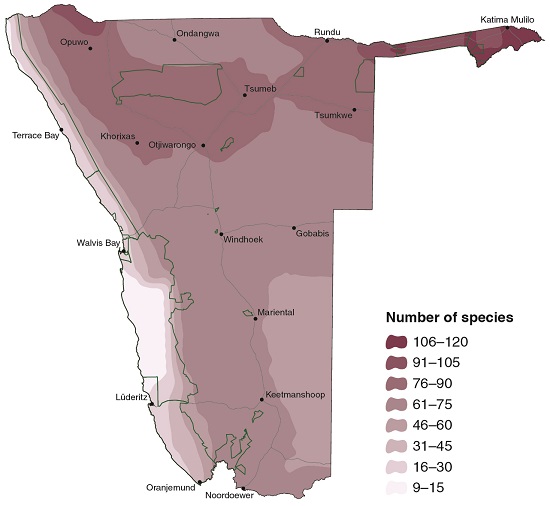
Of the 217 species of mammals in Namibia, the most diverse groups are rodents (53 species), bats (43 species) and carnivores (35 species). Many tropical mammal species are associated with wetlands and forests, and have most of their populations to the north and east of Namibia, with just the southern edges of their ranges within Namibia, and this is shown by the higher diversity in the northeast and in the Kunene River valley. Much of the country has more than 60 species, while the Namib Sand Sea has the lowest diversity with just a tenth of the number of mammal species found in the richest areas of the northeast. See figures 7.07 and 7.08 for more information on the diversity of carnivores and large herbivorous mammals. The patterns of diversity of mammals and birds (figure 7.09) are similar.

Photo: S Hähner
Angolan epauletted fruit bat (Epomophorus angolensis)

Photo: C Begley
Dassie rat (Petromus typicus)
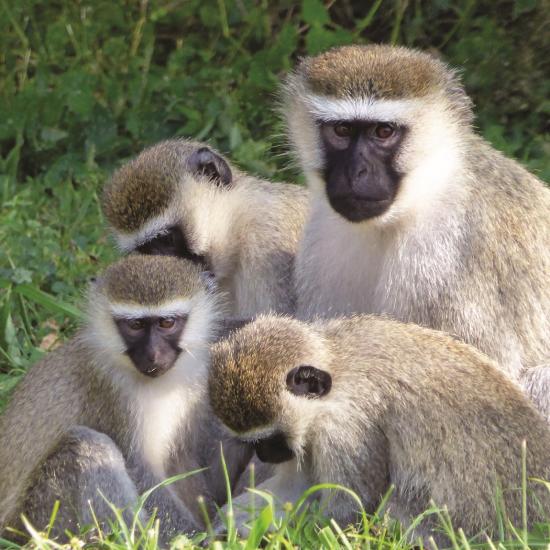
Photo: A Jarvis
Vervet monkey (Chlorocebus pygerythrus)
7.07 Diversity of carnivores18

Namibia's 32 carnivores – mammals in the taxonomic order Carnivora – comprise six large species – cheetah, lion, leopard, brown hyaena, spotted hyaena and African wild dog – and 26 medium-sized and small species. These include cats such as caracal, black-footed cat and serval; dogs such as jackals and foxes; aardwolf, otters, genets, weasel and polecat, honey badger, and 11 species of mongoose. Many of these species occur at very low densities in most areas, are highly secretive or nocturnal, and are seldom seen.
The greatest diversity is found in northeastern Namibia where there is the combination of wetlands, high rainfall and dense vegetation, and where a few tropical species find suitable habitat not available elsewhere in Namibia. These wetter areas are home to carnivores such as otters, rusty-spotted genet, African striped weasel, and three kinds of mongoose. Also noticeable for their relatively higher diversity than the surroundings are the Kunene and Orange rivers, where waterdependent species such as otters and water mongoose add to the diversity.
The diversity of mammal carnivores across most of the northern half of the country, at more than 18 species, is high. These areas are home to species such as civet and serval, banded mongoose and dwarf mongoose, and Namibia's only endemic carnivore, the black mongoose, that inhabits mostly rocky outcrops in northwestern Namibia.
A few species such as honey badger and striped polecat are widespread throughout the country except the Namib Sand Sea, while some species are true generalists that can survive even in the sandy Namib. These include the ubiquitous black-backed jackal, caracal and African wild cat.
7.08 Diversity of large herbivores19

The map shows the diversity of 16 species of herbivores ranging in size from springbok to elephant. There are essentially two groups – savanna species and wetland species. Zambezi Region has populations of hippopotamus, buffalo and waterbuck that are associated with wetland and floodplain habitats, while Etosha National Park and the areas south and west of it support high numbers of species such as springbok, Burchell's zebra and giraffe. Some herbivores have rather localised distributions while others are very widespread (figures 7.38–7.46). Many species make seasonal movements, following rainfall and the new growth that it stimulates. The lowest numbers of species are in the densely populated northern regions, as well as in the far west and south, where there is relatively little vegetation.

Photo: J Mendelsohn
7.09 Diversity of birds20
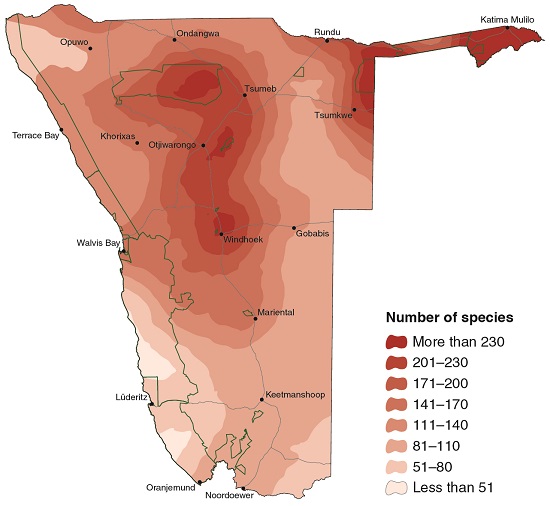
An impressive total of 676 bird species has been recorded in Namibia due to the variety of habitats found within its borders, namely desert, savanna, grassland, riverine forests, wetlands, coastal shores and ocean.21 Species richness is highest in the northeastern areas where rainfall is relatively high, and where four of the country's six perennial rivers and associated wetlands are found. Diversity is also high in the central parts of the country where mountains, savanna and pan systems contribute to a high level of habitat complexity. The savannas in the central parts of the country support a higher diversity than the more arid areas to the west and south and, surprisingly, more than the higher rainfall areas to the east where woodlands on deep Kalahari sands are poor in nutrients and low in habitat diversity. There are several key areas for birds along the coast, where offshore islands and coastal lagoons offer critical feeding and breeding spaces. Some of these are especially important for migrants that rely on these small but vital habitats during the southern hemisphere summer. Namibia has 21 areas designated as 'important bird areas' (figure 7.10).22
Seventy-eight of Namibia's bird species are on the IUCN's Red list, indicating significant threats to these species' survival.23 Threats arise predominantly from four main impacts of human activities: degradation of habitats such as wetlands, savannas and forests; poisoning of scavengers; overfishing and destructive fishing methods in the ocean; and collisions with power lines.
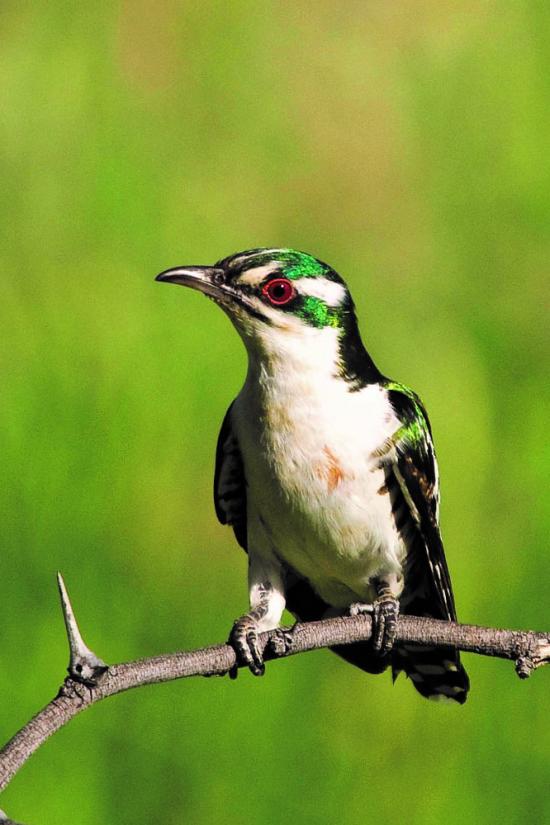
Photo: P Lambrecht
Diederik cuckoo (Chrysococcyx caprius)
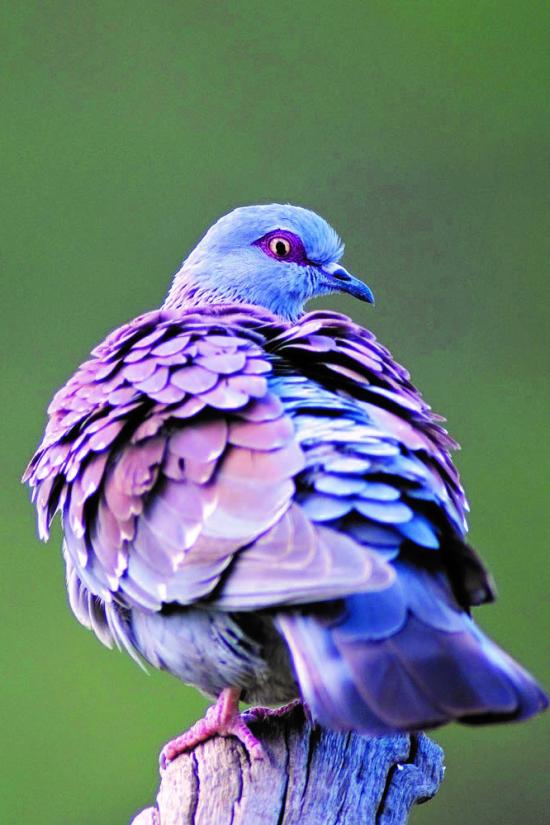
Photo: P Lambrecht
Speckled pigeon (Columba guinea)

Photo: C Begley
Namaqua sandgrouse (Pterocles namaqua)

Photo: J Kemper
Swift tern (Sterna bergii)

Photo: P Lambrecht
Marabou stork (Leptoptilos crumeniferus)

Photo: T Robertson
Red-necked falcon (Falco chicquera)
7.10 Important Bird Areas24
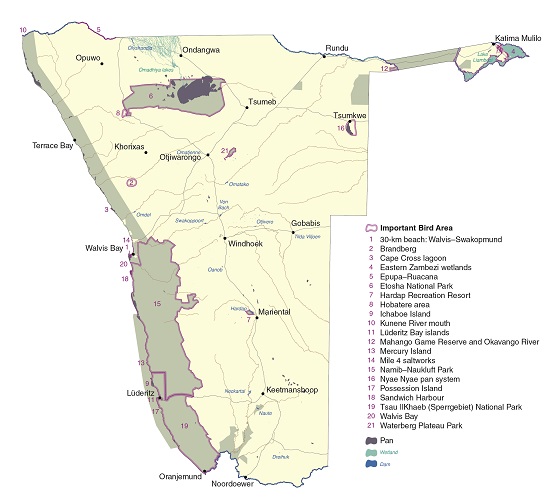
Areas with high concentrations of birds, particularly with significant numbers of threatened or endemic species or with more than one per cent of the global population of any species, are recognised as 'important bird areas'. These areas do not necessarily enjoy legal protection, but they are identified as valuable for sustaining bird as well as other life on Earth. Because birds can readily be identified and counted, the size and trend of their populations can reveal useful information on aspects such as the quality of water resources or the state of the food they rely on.
Many of Namibia's wetlands are identified as important bird areas; almost a third of the country's bird species depend on rivers, lakes and lagoons and their associated floodplains, marshy habitats and shorelines for at least part of their life cycle. Wetlands are rich sources of food such as fish, frogs and invertebrates (figures 7.12, 7.13, 7.15) and they support reedbeds and dense stands of trees along riverbanks, which create places for nesting and shelter. Five of Namibia's wetlands are recognised as Wetlands of International Importance under the Ramsar Convention (figure 8.09), four of which are at the coast, and are vital feeding and stop-over posts for migratory shorebirds.
Areas of critical importance for seabirds are the offshore islands in the vicinity of Lüderitz. Penguins, gannets and cormorants cluster on these islands where they are safe from land predators such as jackals and hyaenas. These fall within the Namibian Islands' Marine Protected Area (figure 7.05). Namibian populations of Cape gannet and African penguin – the only penguin species that breeds on the continent – have dropped by over 60 per cent in the past 40 years, largely due to human overexploitation of their main food items, sardines and anchovies.
Some of the important bird areas are entire national parks, such as Namib-Naukluft and Tsau//Khaeb. These are justified in that they support significant populations of endemic and nearendemic birds, and are also important areas for raptors, such as threatened lappet-faced vultures and secretarybirds.
Many of these important bird areas are attractive tourist destinations, offering the exhilaration of wilderness and wildlife of undisturbed natural areas, and provide important economic returns to the country.
7.11 Diversity of reptiles25

Reptile diversity is highest in the central highlands (up to 79 species), while the escarpment and associated highlands are also notably diverse due to the mosaic of habitats and numerous inselbergs, which provide important refugia for many species. The eastern Zambezi Region supports a large number of species due to the higher rainfall and abundance of aquatic habitats in this area; some of these species also occur in central Africa.
Namibia supports some of the richest reptilian assemblages in Africa, with a total of 292 species including 173 lizard and 93 snake species. It boasts the second highest tortoise diversity (at least six species, and six more terrapins) in Africa. Lizards are the most diverse group, with the family of geckos comprising 25 per cent (73 species) of all reptile species found in Namibia. Ongoing phylogenetic studies show that some Namibian reptile species remain undescribed.

Photo: F Becker
Barking geckos (Ptenopus) are some of the most common vertebrates in the arid areas of Namibia. Their loud calls are iconic sounds of the desert, and are emitted by males to attract females to their burrows. The males also have a bright yellow throat patch, which is thought to act as a mating and territorial signal. Three species are currently recognised.

Photo: P Cunningham
The Nama padloper (Chersobius solus) is the second smallest tortoise in the world, and occurs in a small part of the southern Namib Desert around Aus. This tortoise has a flattened shell, which allows it to crawl under rocks to shelter from harsh conditions. It is the only tortoise known to drink fog that condenses on its shell and on rocks.
7.12 Diversity of amphibians26
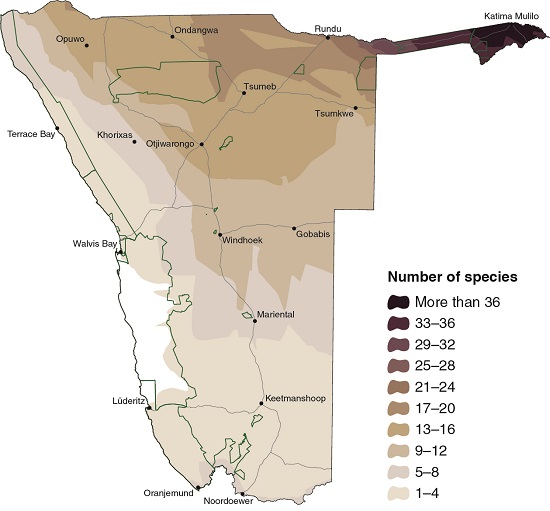
Amphibian diversity is highest in eastern Zambezi Region (40 species) and decreases with average rainfall, due to their dependence on surface water for breeding. Their activity is highly seasonal, and most species will not be detected outside the rainy season. Perennial waterbodies are often dominated by a few species with high numbers of animals, while small, temporary waterbodies tend to accommodate a greater range of species. Twelve amphibian families occur in Namibia, the most diverse being toads (14 species) and bullfrogs and sand frogs (16 species). While most species breed in open water, the rain frogs breed in subterranean tunnels and occur independently of waterbodies. One species even occurs in the sand dunes of the southern Namib Desert. There have been few studies on Namibian amphibians and it is likely that Namibia has more than the 63 species currently recognised.

Photo: J Mendelsohn

Photo: F Becker
Namibia boasts one of the world's largest amphibians, the giant bullfrog (Pyxicephalus adspersus), which is considered a delicacy by many Namibians. These frogs may take decades to reach adult size. Breeding occurs in ephemeral pans after heavy rainfall, and males fight viciously for breeding privileges. The male often remains after breeding to guard the tadpoles, even digging channels to allow them to move to deeper pools when their pool dries up
7.13 Diversity of freshwater fish27

Most of the 115 species of freshwater fish in Namibia are in the northern river systems. Many of these species occur in more than one river system, but not all the species reported from a river system are present along the whole course of the river. Seventeen species have been recorded as occurring naturally in the iishana of the Cuvelai drainage system, while another 46 species were introduced to the iishana via the canal from the Calueque Dam (figure 4.21) on the Kunene River. Six species have been recorded in the ephemeral rivers that flow to the coast, and 11 species occur in man-made dams, such as Von Bach, Hardap and Omatako.
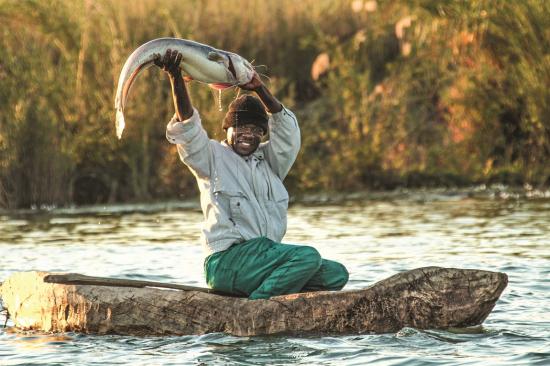
Photo: J & S Hurd
Catfish ("Barbel") Clarias sp.
7.14 Movements of African tigerfish in the Okavango River28
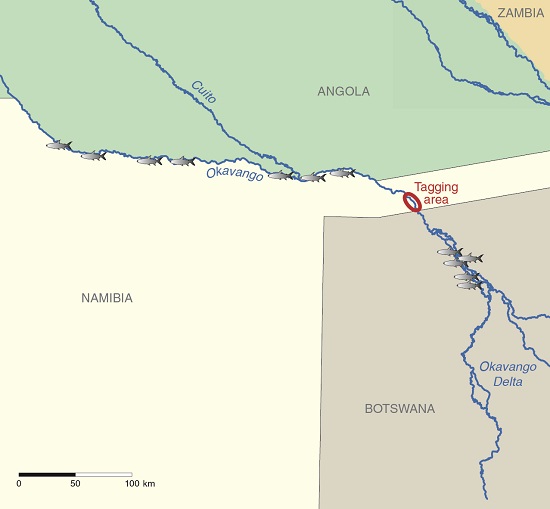
There is little information on how African freshwater fish use various parts of the river systems they live in for feeding, spawning and colonising new habitats. A telemetry study of African tigerfish (Hydrocynus vittatus) in the Okavango River has shown that some of these large predatory fish are migratory, and move between Namibia and Botswana, while others stay resident in a short stretch of the river. These different behaviours are thought to promote genetic diversity in the population. The map shows the furthest locations recorded for 12 fish that were tagged in Bwabwata National Park. Some individuals moved at least 400 kilometres; this is the longest movement recorded for any freshwater fish species in Africa. Understanding how fish use the river is important for the management and protection of regional populations and their key habitats.
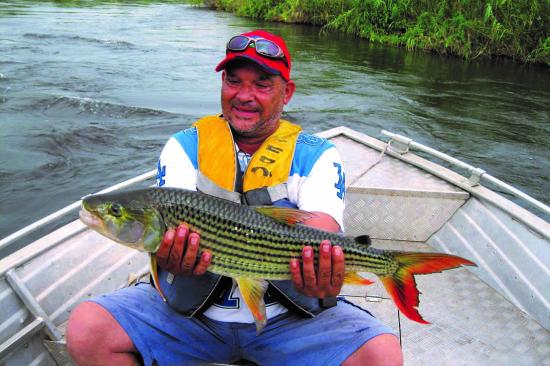
Photo: M van Rooyen
7.15 Diversity of invertebrates29

Invertebrates are the most numerous macroscopic biota on the planet and, unsurprisingly, in Namibia too. The most comprehensive available listing of named and documented Namibian invertebrates currently includes more than 12,000 species, but it is a work in progress and the true number is expected to exceed 16,000. Insufficient data exist to derive a map of overall invertebrate diversity.
As examples of invertebrate diversity, maps of specific, better-studied groups of invertebrates follow – nematodes, solifuges, termites, tenebrionid beetles and scorpions (figures 7.16–7.20).

Photo: T Robertson
Centipede (Scolopendra morsitans)
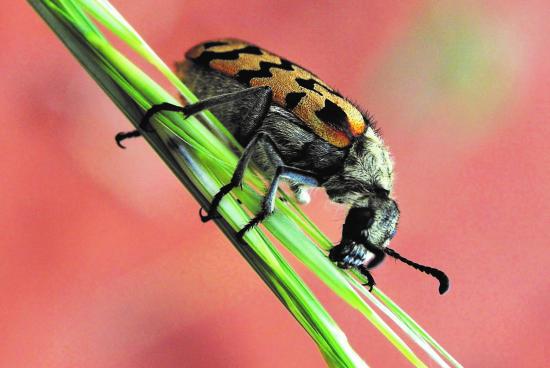
Photo: A Jarvis
Blister beetle (Hycleus dentatus)

Photo: T Robertson
Brown-veined white butterfly (Belenois aurota) migrates every year, travelling hundreds of kilometres from coastal areas of South Africa to Mozambique and towards Madagascar, with many passing through Namibia on the way.
7.16 Diversity of nematodes30
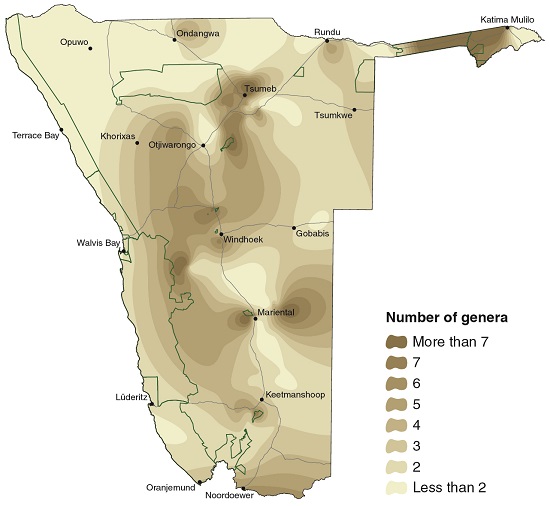
Nematodes, or roundworms, are unsegmented animals belonging to the Phylum Nematoda and are possibly the most abundant animals on Earth. They live in a range of environments including soil, fresh water and salt water, and there are species that feed on fungi, bacteria, protozoans, other nematodes, and plants. They can also parasitise insects, humans and other animals. They range in size from 80 micrometres up to an enormous 8 metre specimen which was found in the placenta of a whale.
This map shows the diversity of nine families of plant-feeding nematodes that live in the soil. Most nematodes found in soil are small, usually from less than one to about ten millimetres in length. Worldwide, over 4,300 plant-feeding nematode species are known, and 65 of these have been reported from Namibia. Plant-feeding nematodes can cause extensive damage to crops. In Namibia, several species are associated with maize and pearl millet.
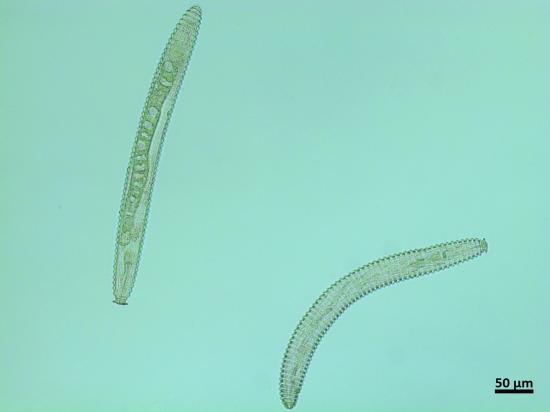
Photo: C Girgan
A nematode in the Criconema genus

Photo: C Girgan
Xiphinema capenses, a dagger nematode that feeds on plant roots
7.17 Diversity of solifuges31
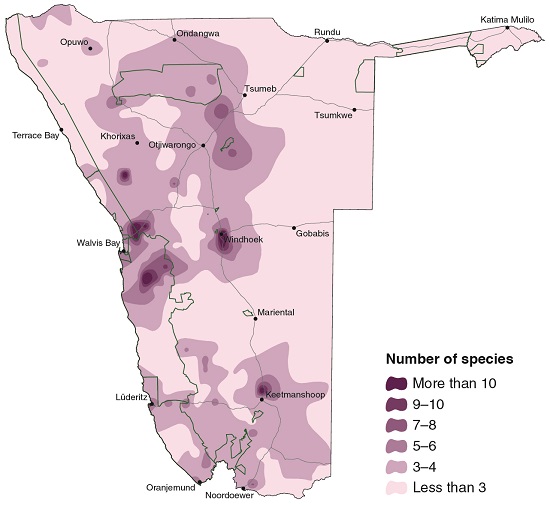
Solifuges, locally known as red romans, sunspiders or Kalahari Ferraris, are arachnids that belong to the order Solifugae. They can be distinguished from spiders by their large, scissor-like jaws. Solifuges are fast running and carnivorous, feeding on prey that they can subdue, such as insects and scorpions and occasionally small lizards, birds and rodents. They are harmless to humans.
Globally, most solifuges occur in arid areas, and Namibia has high levels of diversity and endemism. Currently, 122 species of six families are described from Namibia, including 59 endemic species. Diversity is highest in the more arid western and southern parts of the country, but highlands also provide important habitats. The map indicates a general distributional trend based on current knowledge. However, gaps in the geographic coverage of surveys as well as incomplete taxonomic identification of some specimens could explain the apparent low diversity in some areas.

Photo: T Bird
Metasolpuga picta, a diurnal solifuge which is endemic to Namibia.
7.18 Diversity of termites32

Only the number of genera is available to provide a measure of diversity among termites, but a close relationship between numbers of species and genera can be expected. Eastern Zambezi and areas surrounding the Okavango River valley have the greatest diversity, with numbers tailing off towards the southwest, indicative of an association between rainfall and diversity. Pockets of higher diversity are present in the highlands in Kunene Region and in the vicinity of Waterberg.

Photo: J Mendelsohn
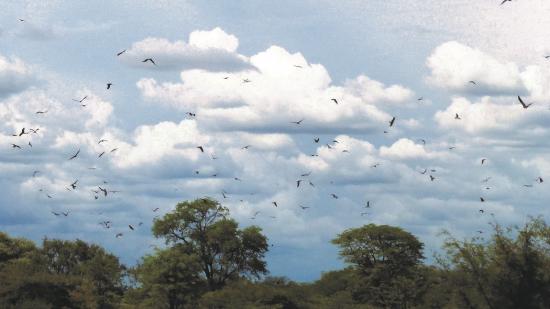
Photo: J Mendelsohn
Huge numbers of termites emerge after the rains and provide an important food source for other animals such as these milvus kites.
7.19 Diversity of tenebrionid beetles33

Namibia has about 600 species of beetles within the family Tenebrionidae, known as darkling beetles or, colloquially, toktokkies due to the tapping sounds some species use to communicate. Their abundance and diversity tends to be highest in the driest parts of the country, peaking in the central Namib where there are over 80 species.

Photo: P van Schalkwyk
Many tenebrionid beetles in the Namib Desert are active by day, foraging for food (mostly dry plant matter) or searching for mates. In this area where rain rarely falls, they often also venture from their underground shelters at night to collect moisture from fog or dew. Two species of fog-basking beetles are particularly iconic, doing 'headstands' on top of dunes during foggy conditions; they orientate their bodies so that the fog condenses on their abdomens and runs down towards their mouths. Many other species also come out to drink water droplets that have condensed on grass or sand. Although there is no shortage of theories, none fully explains why there are so many tenebrionid species in the Namib Desert.
7.20 Diversity of scorpions34

Many species of scorpion are adapted to arid areas, and this is where most occur, especially in rocky areas in southern and western Namibia. By contrast, there are few species in the predominantly sandy areas of the eastern half of the country and in the Namib dunes.
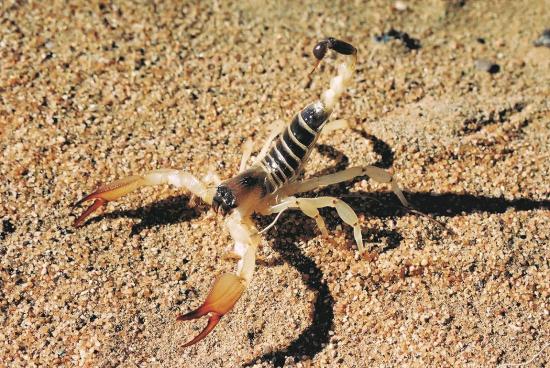
Photo: J Pallett
Opistophthalmus adustus, a species of burrowing scorpion
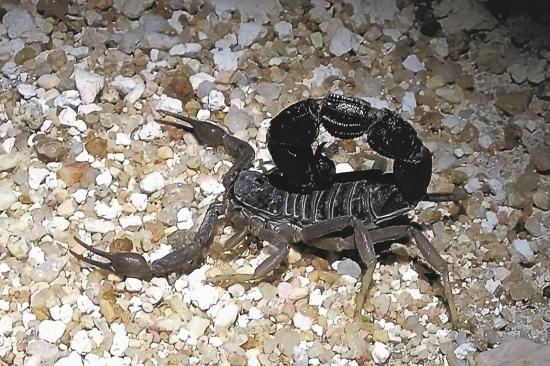
Photo: C Begley
Parabuthus granulatus, Namibia's most venomous scorpion

